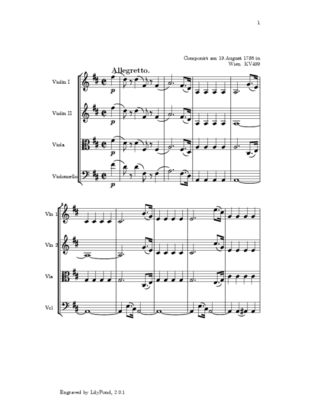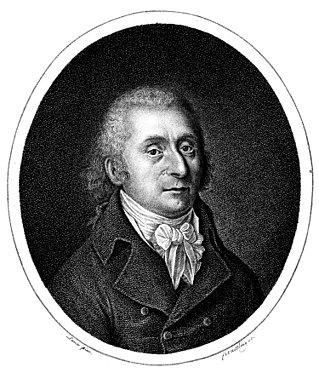The Alban Berg Quartett was a string quartet founded in Vienna, Austria in 1970, named after Alban Berg.

The Melos Quartet was a much-recorded, Stuttgart-based string quartet active from 1965 until 2005, when its first violinist died. It also went by the name Melos Quartett Stuttgart, partly to distinguish itself from the equally prominent chamber group the Melos Ensemble of London.

The String Quartet No. 20 in D major, K. 499, was written in 1786 in Vienna by Wolfgang Amadeus Mozart. It was published by – if not indeed written for – his friend Franz Anton Hoffmeister. Because of this, the quartet has acquired the nickname Hoffmeister. Hoffmeister had started issuing a series of chamber-music publications in 1785, including Mozart's K. 499 as well as Joseph Haydn's Op. 42.

Franz Anton Hoffmeister was an Austrian composer and music publisher.
E-flat major is a major scale based on E♭, consisting of the pitches E♭, F, G, A♭, B♭, C, and D. Its key signature has three flats. Its relative minor is C minor, and its parallel minor is E♭ minor,.

Franz Schubert's final chamber work, the String Quintet in C major is sometimes called the "Cello Quintet" because it is scored for a standard string quartet plus an extra cello instead of the extra viola which is more usual in conventional string quintets. It was composed in 1828 and completed just two months before the composer's death. The first public performance of the piece did not occur until 1850, and publication occurred three years later in 1853. Schubert's only full-fledged string quintet, it has been praised as "sublime" or "extraordinary" and as possessing "bottomless pathos," and is generally regarded as Schubert's finest chamber work as well as one of the greatest compositions in all chamber music.

Tabea Zimmermann is a German violist who has performed internationally, both as a soloist and a chamber musician. She has been artist in residence of the Concertgebouw Orchestra, the Berlin Philharmonic, and the Bavarian Radio Symphony Orchestra. In 2004, Zimmermann founded the Arcanto Quartet, a string quartet that performed until 2016. Several composers have written music for her, including György Ligeti, and she has made her own version of Bartók's Viola Concerto from the composer's sketches.
Walter, Knight Boeykens was a Belgian conductor and a world-renowned clarinetist. Boeykens' impressive discography, including several critically acclaimed performances, are testimony to his status as one of the most notable clarinetists of the 20th century. Boeykens remained active and was in concert frequently all around the world until his death in 2013.
Paul Lewis is an English classical pianist.

Mozart's Piano Quartet No. 1 in G minor, K. 478, is scored for violin, viola, cello, and pianoforte. It was composed in 1785.

Dezső Ránki is a Hungarian virtuoso concert pianist with a broad repertoire and a significant discography of solo, duo and concerto works.

The Fantasia in F minor by Franz Schubert, D.940, for piano four hands, is one of Schubert's most important works for more than one pianist and one of his most important piano works altogether. He composed it in 1828, the last year of his life. A dedication to his former pupil Caroline Esterházy can only be found in the posthumous first edition, not in Schubert's autograph.

Anton Bruckner's String Quintet in F major, WAB 112 was composed in 1878/79 in Vienna.

The String Quartet in C minor WAB 111, was composed by Anton Bruckner's in 1862 during his tuition by Otto Kitzler.
Leonard Hokanson was an American pianist who achieved prominence in Europe as a soloist and chamber musician.

The Four Orchestral Pieces are four short orchestral pieces, which Anton Bruckner composed in the fall of 1862 during his tuition with Otto Kitzler.
The Signum Quartet is a string quartet based in Bremen, Germany. Founded in 1994, it has been playing in the current formation since 2016.
The String Quartet in E-flat major was composed by Johann Baptist Wanhal around 1785, like Mozart's D major String Quartet K. 499, the composition was dedicated to Franz Anton Hoffmeister and has become known by the nickname Hoffmeister Nº. 2.
The Klenke Quartet is a German string quartet.
Traditionally, a clarinet quartet is a chamber musical ensemble made up of one clarinet, plus the standard string trio of one violin, one viola and one cello. Nowadays, the term clarinet quartet can also refer to a combination of four clarinets of any size [including (contr)alto and (contra)bass clarinet, and basset horn]. The term is also used to refer to a piece written for any of these ensembles.








